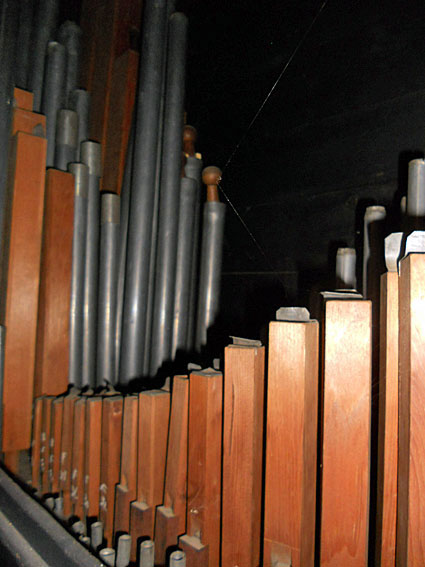
Darnum Musical Village : exterior of church
[photograph by Anthony Hahn (15 May 2011)]
Historical and Technical Documentation by John Maidment
© OHTA (last updated June 2011)

Darnum Musical Village : exterior of church
[photograph by Anthony Hahn (15 May 2011)]
Darnum Musical Village was set up in 1981 to provide an appropriate venue for the display of historic keyboard instruments of which more than 300 are exhibited. These mainly consist of reed organs, but includes a William Anderson organ from the 1870s.1
The Geelong Advertiser for 22 March 1877 reported on the opening of a new organ at the Baptist Church, Fenwick Street, Geelong:
The worshippers at the Fenwick Street Baptist Church will soon hear the musical sounds of a fine organ in their services of worship in the place of the harmonium which has done them so much service for a number of years. A new instrument has been made by Mr William Anderson of Flinders Lane, East Melbourne, who is well known in this town and it is now in course of erection at the church in question. The maker expects to have the work of erecting it completed on Friday. We understand that an organ recital will take place in the church on the 28th. inst., when Mr Martin Forder, the blind organist from the Blind Asylum in Melbourne, will preside. The choir of St Paul's Church, assisted by Messrs J.E. Down, J.S. Begley, W.D. Goodall and others have consented to assist at the recital.
The organ is a full scale church one CC to G with 56 notes and seven stops enclosed in a swell box, the open diapason being outside of the swell in order to produce the effect of two manuals. It contains the following stops:
| No.1 No.2 No.3 No.4 No.5 No.6 No.7 |
Open Diapason Stopped Diapason [Gedact] Dulciana Principal Flute Fifteenth |
metal wood metal metal metal wood metal |
8 feet pitch 8 foot pitch 8 foot pitch 8 foot pitch 4 foot pitch 4 foot pitch 2 foot pitch |
CC to G CC to B C to G CC to G CC to G CC to G CC to G |
fifty-six pipes twelve pipes forty-four pipes forty-four pipes fifty-six pipes fifty-six pipes fifty-six pipes |
It also has three composition pedals for combinations, one swell pedal and thirty German pedals.
The organ will be fifteen feet in height, seven feet in width and five feet in depth. It will be enclosed within a plain case grained and varnished and fitted with a speaking pipe front, the pipes being illuminated with gold and neat colours. The metal pipes have been imported but the rest of the work is of colonial manufacture, well seasoned so as to stand sudden changes of climate, and the instrument has been fitted with all the latest improvements. The cost of the organ is £170, the work of fixing it in the church being an extra expense. Of course nothing can be said in respect of the power of the organ until a trial has taken place, but Mr Anderson's previous reputation as an organ manufacturer may be taken as a criterion of the excellence of the work at present in hand. The organ is so constructed that it can be enlarged if necessary. It is being erected at the east end of the church, fronting Fenwick Street.2

Methodist Church, Naringaningalook : organ before 1991
[photograph by Bill Smith (1980s)]
Around 1922 the organ was moved to the Methodist Church, Union Street, Brunswick and further moved to the Methodist Church, Naringaningalook, in northern Victoria, by Charles Lomas in 1960 who made minor changes and additions.3 From there it was moved to its present location at Darnum in 1991-92 where it was installed by Albert Fox.

Darnum Musical Village : organ
[photograph by Anthony Hahn (15 May 2011)]

Darnum Musical Village : organ – detail of facade pipes
[photograph by Anthony Hahn (15 May 2011)]

Darnum Musical Village : console
[photograph by Anthony Hahn (15 May 2011)]
The instrument is a standard example of Anderson's work and similar to the organ that was placed in St Joseph's Catholic Church, Collingwood until its destruction by fire. The metal Gedact, with turned wooden stoppers, very similar to those made by the Hill & Son firm, is believed to be unique in Anderson's oeuvre.
After its installation at Darnum, the façade pipes were repainted although not to historic patterns.
| MANUAL Open Diapason Stopped Diapason Gedact Dulciana Principal Flute Fifteenth Pedal Coupler Tremulant PEDAL Bourdon |
8 8 8 8 4 4 2 16 |
unenclosed CC-BB TC TC * * * |
Compass: 56/30
3 composition pedals
Balanced swell pedal (in place of lever pedal) *
Mechanical key and stop action
* Changes to original organ (by Lomas)

Darnum Musical Village : rear view of organ showing hand blowing
[photograph by Anthony Hahn (15 May 2011)]

Darnum Musical Village : pipework, showing wooden Flute 4 and metal Gedact 8
[photograph by Anthony Hahn (15 May 2011)]
1 The Darnum Musical Village website
http://www.darnummusicalvillage.com.au/?tle=%22Quality+Instruments+built+for+a+lifetime+of+music%22&sel=Home&lay=0 accessed 7 June 2011
2 Cited in Fred Thomas, 'The Naring Organ : Mystery Solved', Victorian Organ Journal, December 1985, p.6
3 Information provided by Fred Thomas to John Maidment